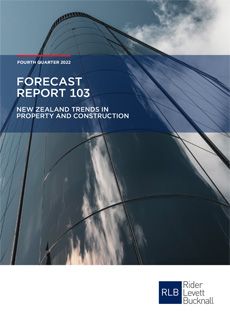Prepared by the New Zealand Institute of Economic Research (Inc.) (NZIER) exclusively for Rider Levett Bucknall (RLB), Forecast 103 found recent indicators point to the construction outlook being split into two halves: solid activity for the first half of 2023 with a softening in construction activity to become apparent from the second half of 2023.
Post publication update
Whilst the construction industry’s workload will no doubt increase due to the post-flood and Cyclone Gabrielle rebuild, insurance assessors will need to spend time assessing the vast damage first. This could take a while and there might be a challenge in securing builders for all the work that will be necessary.
We know from experience that the Christchurch earthquake rebuild took years. Taking into consideration the extent of damage caused by both Cyclone Gabrielle and the recent floods, we will be looking at a long-term rebuild as well.
According to the Rider Levett Bucknall (RLB) Forecast 103 report – New Zealand Trends in Property and Construction – the outlook for the property and construction sector is mixed, with a solid construction pipeline for the meantime.
Fourth Quarter 2022 New Zealand trends in property and construction
RLB Director, Mr Grant Watkins commented, “Although a high level of consent issuance should underpin robust construction activity over the first half of this year, the slowing in building enquiries and drop in new orders and output point to weakening activity from the second half of 2023.”
He added, “Rising interest rates and tighter access to credit are key factors weighing on construction demand. Interest rates have risen sharply over the past year, which is reducing the amount borrowers can borrow. Added to that, banks have become more cautious when it comes to assessing the serviceability of debt for lending on property.”
House sales and prices decline throughout 2022
According to Forecast 103, the most apparent impact of higher interest rates has been on the housing market, with house sales and prices falling over 2022. Real Estate Institute of New Zealand (REINZ) housing market data for December 2022 shows the number of house sales nationwide fell almost 40 per cent from the same month a year ago.
The decline in house prices over the past year was more muted at 13.7 per cent, according to the REINZ House Price Index (HPI). Despite this fall in house prices over the past year, prices are still almost 20 per cent above pre-COVID-19 levels at March 2020.
A further decline in house prices is expected in the face of further interest rate increases and sellers adjusting their house price expectations. Lower house prices should also reduce the incentives for property developers to bring new housing supply onto the market. This should also contribute to weaker residential construction demand later this year.
Infrastructure construction expected to ramp up
Mr Grant Watkins continued, “As private sector construction eases, we expect this will free up capacity for infrastructure construction to ramp up further. Te Waihanga, the New Zealand Infrastructure Commission estimates the National Infrastructure Pipeline increased to $76.9 billion in the third quarter of 2022, with $12.9 billion of this forecast to be spent in 2023.
“Much of this infrastructure spending in the near term is expected to be focused on social housing, education, health and community facilities,” he said.
Intense cost pressures continue
Building sector firms face many headwinds. Demand is starting to soften, but firms face continued intense cost pressures in the construction sector, with over 80 per cent of building sector firms reporting higher costs in the December 2022 quarter. However, only 36 per cent of building sector firms raised prices that quarter, suggesting a further squeezing of operating margins as softer demand limits the ability of firms to pass on higher costs. However, a net 65 per cent of building sector firms are expecting to increase their prices in the March 2023 quarter.
Stronger demand for office and storage buildings
Over the past year, growth in non-residential construction demand has been driven by stronger demand for office and storage buildings. Demand for the construction of health facilities also increased over the past year, although to a much lesser extent.
This growth contrasts with the reduced demand for the construction of accommodation buildings over the past year, reflecting the effects of international border restrictions in recent years.
Building consents by sector
Forecast 103 noted that stronger demand for the construction of office buildings led to an increase in non-residential construction demand over the past year. This largely reflected demand for new office buildings, although consent issuance for alterations to office buildings also increased over the past year.
Mr Watkins said, “While this should support a solid pipeline of construction work, we expect increased caution amongst businesses will weigh on demand for new office buildings over the longer term. Demand for the construction of storage buildings also grew strongly over the past year, reflecting the renewed focus amongst businesses to bolster the resilience of their supply chains.”
Construction of health facilities slows down
“This is in response to the disruptions in manufacturing and logistics arising from the COVID-19 pandemic. We expect demand for construction in this sector to remain strong over the coming year. Growth in demand for the construction of health facilities has slowed, although it remains in the top three drivers of growth in non-residential construction,” he added.
The COVID-19 pandemic increased the demand for healthcare. Over the longer term, we expect the ageing New Zealand population to support continued demand for healthcare facilities. As many households face higher mortgage repayments over the coming year with the repricing of fixed term mortgage rates, the slowing in retail spending should weigh on demand for new retail outlets.
Weaker tourism spending impacts demand for accommodation buildings
Meanwhile, demand for accommodation buildings has declined over the past year, reflecting the effects of weaker tourism spending and population growth due to international border restrictions. RLB expects a recovery in international tourism will support increased demand for accommodation buildings over the coming year. This recovery will be tempered to some degree by the effects of rising interest rates globally, which would likely see households rein in discretionary spending.
Auckland leads the way in consent issuance
Non-residential construction consent issuance was mixed across the regions, with growth largely concentrated in the main centres. Auckland led the way with strong growth in consent issuance over the past year, particularly for healthcare facilities, office and storage buildings. This growth more than offset reduced demand for the construction of accommodation buildings and retail outlets, reflecting the impact of the relatively weak Auckland housing market on the household sector.
RLB expects non-residential construction demand in the region to slow over the coming year as the impact of interest rates and weaker housing market flow through to broader economic activity. Growth in non-residential consent issuance in Waikato was a distant second, with stronger demand for healthcare facilities and education buildings driving this growth over the past year.
Stronger demand for storage and social buildings in Canterbury
Meanwhile, Canterbury continued to see stronger demand for non-residential construction largely because of increased demand for storage and social buildings. This more than offset weaker demand for accommodation buildings and healthcare facilities over the past year. In contrast, there was a substantial decline in non-residential consent issuance in Taranaki over the past year. This largely reflected reduced demand for the construction of healthcare facilities in the region.
According to Forecast 103, RLB expects quarterly increases in non-residential construction costs to persist near current levels for the first half of 2023, reflecting the lingering effects of intense cost pressures in the construction sector.
Capacity pressures expected to ease
Mr Watkins concluded, “In annual growth terms, this will mean further moderation in non-residential construction cost inflation. We expect capacity pressures to ease over the coming years as the relaxation of immigration settings helps alleviate labour shortages, while the easing in global shipping costs reduces other costs.”
“Nonetheless, we expect annual non-residential construction cost inflation to remain above 5 per cent at the end of this year, reflecting the construction sector’s high inflation environment. Beyond 2023, we expect further easing in capacity pressures in the construction sector will drive annual non-residential construction cost inflation to below 3 per cent later in 2026,” he said.
FURTHER INFORMATION:



